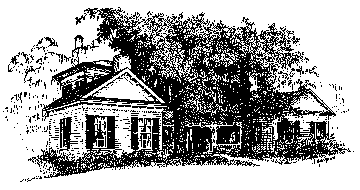In 1834, Georgia Methodists established the Georgia Methodist Conference Manual Labor School near Covington. Two years later, the conference decided to expand the school and chartered Emory College, named in honor of Bishop John Emory, who had died the year before.
Early in 1837, 1452 acres of land were purchased two miles from the Manual Labor School. Some 330 acres were set aside for the college town, which was named Oxford in honor of the Wesleys’ university. Oxford was the first Methodist collegiate community of its kind in American Methodism.
The town plan was designed by Edward Lloyd Thomas, a Methodist pastor and surveyor who also planned Columbus, Georgia. All of Oxford’s streets were named for notable Methodists, and all the main streets converged on the site of the college’s central building.
Many prominent southern Methodists were associated with the town and the college. Oxford was the longtime residence of Bishop James O. Andrew, whose slaveholding precipitated the long-anticipated schism between northern and southern Methodism in 1844.
Bishop Atticus Haygood was president of Emory In 1880 he delivered a Thanksgiving Day sermon to the college community titled “The New South: Gratitude, Amendment, Hope,” which helped launch southern Methodism into a new era of race relations and social reform. Haygood declared, “there is one great historic fact which should, in my sober judgment, above all things, excite everywhere in the South profound gratitude to Almighty God: I mean the abolition of African slavery.”
More than 20 nineteenth century buildings and sites related to Methodism are still standing. Among these places are original college buildings and homes. Also, Oxford Cemetery is the resting place for numerous southern Methodist leaders, including eight Presidents of Emory College. The oldest house in Oxford, Alexander Means’ House, was built by a Virginian in the early 1820s before the town was laid out.
Emory College moved to Atlanta in 1919 to become the College of Arts and Sciences of Emory University, which was chartered in 1915 by the Methodist Episcopal Church, South. A junior college was founded in Oxford in 1929; today it is called Oxford College of Emory University.
Points of interest at this Heritage Landmark: Walking tours of the town has been developed, noting some twenty-three buildings and locations related to United Methodist history. The City of Oxford self-guided tour may be found online at : http://www.oxfordgeorgia.org/OxfordSelf-GuidedTour.aspx. A walking tour of Oxford Historical Cemetery (including many famous Methodists) can be found at: http://www.oxfordgeorgia.org/Historical.aspx.
College buildings include Seney Hall (1881), Candler Hall (1897), the President’s Home (1837), the Prayer Chapel (1875), and Few Hall (1852; an outstanding example of Greek Revival architecture). Historic homes include the Alexander Means House (ca.1820), Stone House (ca.1837), and Hopkins House (1850). Oxford Cemetery has graves dating from the town’s founding, and the Soldiers’ Cemetery is the final resting place of twenty-five Confederate soldiers. Visitors may also see “Old Church,” whose central section was built in 1841, and the Allen Memorial Methodist Church, built in 1910.
There is ample parking at the college and on city streets. Restroom facilities are available at the college.
Special events: There is a Fourth of July community parade that ends with a picnic at Old Church. Tours of historic homes are occasionally offered.
Area attractions: Oxford is now home to Oxford College of Emory University. The current home of Emory University is in nearby Atlanta, which also has numerous cultural attractions.
To visit: The entire town of Oxford is a Heritage Landmark. None of the historic homes is open to visitors, but all may be viewed from the outside during daylight hours. The cemetery, the churches, and the college buildings are open to visitors. A brochure which maps the location of the many historic buildings in the town is available (see addresses below).
Visitors may wish to contact the Oxford College for a guided tour of the college (Oxford College, 801 Emory Street, Oxford, GA 30054; 770-784-8888; http://oxford.emory.edu/about/location/index.html).
Location: Within the boundaries of the North Georgia Annual Conference, in Newton County. Oxford is thirty-five miles east of Atlanta on Interstate 20.
Food and lodging: Many restaurants and hotels are available in Covington, GA. More information can be found through the Chamber of Commerce at http://gocovington.com/Tourism.
Directions: Leave Interstate 20 at the Covington-Oxford exit and follow signs to Oxford College of Emory University.
For further information, contact: President, Oxford Historical Shrine Society, P.O. Box 245, Oxford, GA 30054; 770-786-7004.
To learn more about United Methodist history in this area:
North Georgia Annual Conference Archivist, Brandon Wason, Pitts Theology Library, Emory University, Atlanta, GA 30322; bwason@emory.edu.
North Georgia Annual Conference Commission Chair, Ginger Smith, virginia.smith@emory.edu.
Henry M. Bullock, A History of Emory University (Atlanta: Cherokee Pub. Co., 1972).
Harold W. Mann, Atticus Greene Haygood, Methodist Bishop, Editor, and Educator (Athens: University of Georgia Press, 1965).
Mark Auslander, The Accidental Slaveowner: Revisiting a Myth of Race and Finding an American Family(Athens: University of Georgia Press, 2011).

